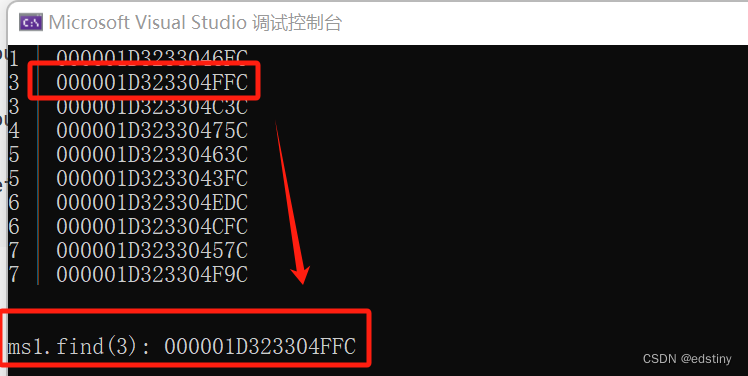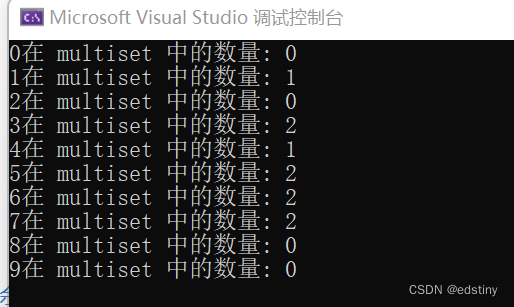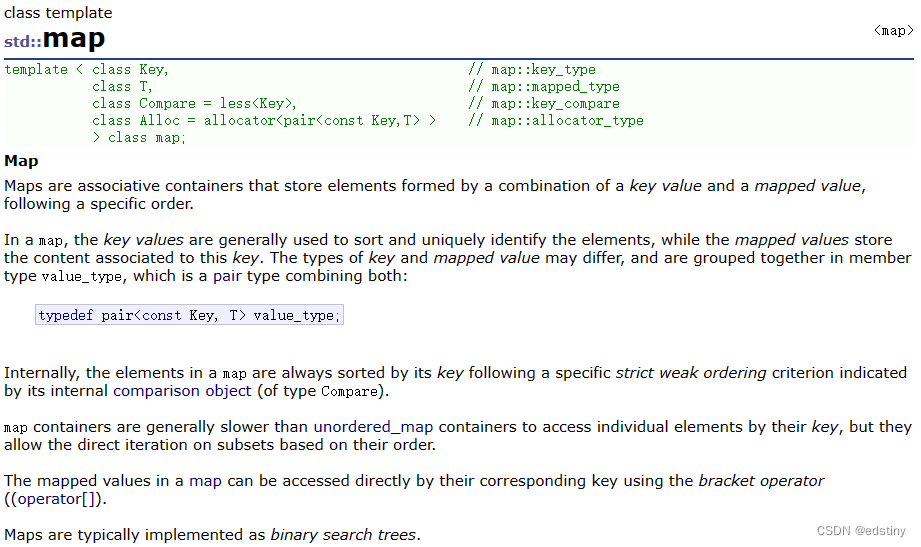
目录
0. 引言
在之前的博客中,我们已经介绍过 STL 中的部分容器,例如:vector,list,deque等,这些容器统称为序列式容器,因为其底层为线性序列的数据结构,里面存储的是元素本身。而本节我们介绍的 map 以及set 属于关联式容器,那什么是关联式容器?它与序列式容器有什么区别?
关联式容器也是用来存储数据的,与序列式容器不同的是,其里面存储的是结构的键值对,在数据检索时比序列式容器效率更高。
那么接下来我们一起逐步开始学习吧!
1. 关联式容器
我们之前学习过的序列式容器底层为线性序列的数据结构,例如 list ,其节点是线性存储的,一个节点存储一个数据,但这些数据未必有序。而关联式容器则比较特殊,存储的是 <key, value> 的键值对, 这意味着可以按照键值大小 key 以某种规则放置在适当的位置,因此,关联式容器没有首位的概念,因此没有头插尾插等相关操作。
那什么是键值对呢?我们接着来看。
2. 键值对
键值对是用来表示具有一一对应关系的一种结构,该结构中一般只包含两个成员变量key和value,key代 表键值,value表示与key对应的信息。
比如:现在要建立一个英汉互译的字典,那该字典中必然 有英文单词与其对应的中文含义,而且,英文单词与其中文含义是一一对应的关系,即通过该应 该单词,在词典中就可以找到与其对应的中文含义。
在标准库中,专门定义了键值对 pair :
//SGI 版 STL 中的实现
template <class T1, class T2>
struct pair {
typedef T1 first_type;
typedef T2 second_type;
T1 first;
T2 second;
pair() : first(T1()), second(T2()) {}
pair(const T1& a, const T2& b) : first(a), second(b) {}
#ifdef __STL_MEMBER_TEMPLATES
template <class U1, class U2>
pair(const pair<U1, U2>& p) : first(p.first), second(p.second) {}
#endif
};
其中, pair 中的 first 表示键值, second 表示实值,在给 关联式容器中插入数据时,就可以构建键值对 pair 对象。
例如,下面构建了一个键值 key 为 string,实值 value 为 int 的匿名键值对 pair 对象。
pair<string, int>("hello", 123);此外,库中还设计了一个函数模板 make_pair, 可以根据传入的参数,去调用 pair 构建对象并返回。make_pair 实际会被编译器优化为 内联函数,因此不会造成过多消耗,可以放心使用
//make_pair 定义:
template <class T1,class T2>
pair<T1,T2> make_pair (T1 x, T2 y)
{
return ( pair<T1,T2>(x,y) );
}
make_pair("hello", 123)3. 树形结构
在 C++ 中提供了四种树形结构的关联式容器。set / multiset / map / multimap。

基于哈希表的,我们将在后续详细介绍。
4. set
4.1 set 的定义
set 实则是二叉搜索树中的 key 模型。key 模型主要的应用场景是判断在不在,例如:门禁系统,车库系统,检查文章中单词拼写是否正确等。
set 只包含实值 value,或者说, 实值就是键值,键值就是实值。
其参数的解释如下:
template < class T, // 实值(键值)
class Compare = less<T>, // 存储依据,默认为升序
class Alloc = allocator<T> // 空间配置器
> class set;接着我们来看 set 的使用。
4.2 set 的构造
我们首先来看构造函数:

在这里我们创建时,需要指定实值的类型。
#include<iostream>
#include<vector>
#include<set>
using namespace std;
int main()
{
vector<int> arr = {1,4,5,6,8,8,5,3,2,9};
set<int> s1;//创建一个空的 set
set<int> s2(arr.begin(), arr.end());//创建包含数据的 set
cout << "s1: ";
for (auto e : s1)
cout << e << " ";
cout << endl;
cout << "s2: ";
for (auto e : s2)
cout << e << " ";
cout << endl;
return 0;
} 
与二叉搜索树一样, set 不支持数据冗余,冗余数据则无法插入,如果需要插入冗余数据,则需要使用 multiset,我们后续会讲到。
4.3 set 的常用函数
| 功能 | 作用 |
| 迭代器 | 遍历容器 |
| empty | 判断容器是否为空 |
| size | 当前容器中的元素个数 |
| max_set | 容器的最大容量 |
| insert | 将元素插入到特定位置 |
| erase | 删除指定元素 |
| swap | 交换两个容器 |
| clear | 清空容器中的所有元素 |
| find | 查找实值是否存在并返回迭代器位置 |
| count | 统计容器中指定键值的数量 |
下面我们实际演示相关函数的使用,代码如下:
#include<iostream>
#include<vector>
#include<set>
using namespace std;
int main()
{
vector<int> arr = {1,4,5,6,8,3,2,9};
set<int> s1(arr.begin(), arr.end());//创建包含数据的 set
//迭代器遍历
cout << "迭代器遍历结果: ";
set<int>::iterator it = s1.begin();
while (it != s1.end())
{
cout << *it << " ";
++it;
}
cout << endl;
cout << endl;
cout << "empty(): " << s1.empty() << endl;
cout << "size(): " << s1.size() << endl;
cout << "max_size(): " << s1.max_size() << endl;
//插入元素7
cout << endl;
cout << "insert(7): ";
s1.insert(7);
for (auto e : s1) cout << e << " ";
cout << endl;
//删除元素9
cout << endl;
cout << "erase(9): ";
s1.erase(9);
for (auto e : s1) cout << e << " ";
cout << endl;
//交换 查找 清理
cout << endl;
set<int> s2(arr.begin() + 3, arr.end());
s1.swap(s2);
cout << "s1: ";
for (auto e : s1) cout << e << " ";
cout << endl;
cout << "s2: ";
for (auto e : s2) cout << e << " ";
cout << endl;
cout << endl;
cout << "s1.find(3): ";
cout << (s1.find(3) != s1.end()) << endl;
cout << endl;
cout << "s2.clear(): " << endl;
s2.clear();
cout << "s1: ";
for (auto e : s1) cout << e << " ";
cout << endl;
cout << "s2: ";
for (auto e : s2) cout << e << " ";
cout << endl;
return 0;
}结果如下:

那么,count 在 set 中只能用作查找,因为 set 键值就是实值,因为其不允许冗余,因此只有一个键值。
#include <iostream>
#include <vector>
#include <set>
using namespace std;
int main()
{
vector<int> arr = { 1,4,5,6,8,3,2,9 };
set<int> s1(arr.begin(), arr.end());
for (int i = 0; i < 10; i++)
{
if (s1.count(i))
cout << i << " 在 set 中" << endl;
else
cout << i << " 不在 set 中" << endl;
}
return 0;
}
我们也可以根据 set 的构造函数将其排为降序。
#include <iostream>
#include <vector>
#include <set>
using namespace std;
int main()
{
vector<int> arr = { 1,4,5,6,8,3,2,9 };
set<int, greater<int>> s1(arr.begin(), arr.end());
for (auto e : s1)
cout << e << " ";
return 0;
}
最后需要注意的是,键值 key 不允许修改,因为如果改变了,会破坏二叉搜索树的原则,set 中的普通迭代器在本质上也是 const 迭代器。

4.4 set 的特点
最后,我们总结一下 set 的特点:

5. multiset
multiset 与 set 的唯一区别就在于 multiset 插入冗余数据时,不会失败。

由于 multiset 的操作与 set 基本相同,在这里我们主要演示区别。
5.1 multiset 插入冗余数据
先看代码,从中我们可以发现,multiset 允许数据冗余。
int main()
{
vector<int> arr = { 1,3,3,4,5,6,7,5,6,7 };
multiset<int> ms1(arr.begin(), arr.end());
for (auto e : ms1)
cout << e << " ";
cout << endl;
return 0;
}
此外,multiset 查找冗余的数据时,返回的是中序遍历中,第一次出现的元素 :
int main()
{
vector<int> arr = { 1,3,3,4,5,6,7,5,6,7 };
multiset<int> ms1(arr.begin(), arr.end());
auto it = ms1.begin();
while (it != ms1.end())
{
cout << *it << " | " << &*(it) << endl;
++it;
}
cout << endl << endl;
cout << "ms1.find(3): " << &*(ms1.find(3)) << endl;
return 0;
}
5.2 multiset - count 的使用
cout 在 multiset中。真正发挥了统计键值数的效果。
int main()
{
vector<int> arr = { 1,3,3,4,5,6,7,5,6,7 };
multiset<int> ms1(arr.begin(), arr.end());
for (int i = 0; i < 10; i++)
cout << i << "在 multiset 中的数量: " << ms1.count(i) << endl;
return 0;
}

6. map
6.1 map 的定义
map 是二叉搜索树改造后的 key / value 模型,是真正意义上的键值对,存在关于应用搜索的应用场景,例如:中英文互译字典,电话号码查询快速信息,电话号码+验证码等。
key / value 模型除了可以用来查找之外,还可以用来统计,其实就是哈希的思想,建立映射关系
模板中 key 就是键值对中的键值, T 为键值对中的实值。 所以 map 也会使用到 pair 结构,其中first 表示键值,second 表示实值。map 也存在迭代器,且为双向迭代器。
6.2 map 的构造
map 有以下构造方法: 
#include <iostream>
#include <vector>
#include <map>
using namespace std;
int main()
{
vector<pair<string, int>> arr = { make_pair("A", 65), make_pair("B", 66), make_pair("C", 67), make_pair("D", 68) };
map<string, int> m1;//创建一个空的 map
map<string, int> m2(arr.begin(), arr.end());//创建包含数据的 map
cout << "m1: " << endl;
for (auto e : m1)
cout << e.first << " | " << e.second << endl;
cout << endl;
cout << "m2: " << endl;
for (auto e : m2)
cout << e.first << " | " << e.second << endl;
return 0;
}

这里在访问 map 中的键值和实值时,需要通过 pair 指定对象访问,例如这里的:e.first 。
6.3 map的常用函数
| 功能 | 作用 |
| 迭代器 | 遍历容器 |
| empty | 判断容器是否为空 |
| size | 当前容器中的元素数 |
| max_size | 容器的最大容量 |
| operator[ ] | 按照键值,访问实值,如果没有,则新插入 |
| insert | 元素插入,根据特定条件插入至合适位置 |
| erase | 删除指定元素 |
| swap | 交换两个容器 |
| clear | 清空容器中的所有元素 |
| find | 查找实值是否存在并返回迭代器位置 |
| count | 统计容器中指定键值的数量 |
这里函数的使用方法与 set 基本相同,但新增了一个 operator[ ]。 下面我们来看演示:
#include <iostream>
#include <vector>
#include <string>
#include <map>
using namespace std;
int main()
{
vector<pair<string, int>> arr{ make_pair("C", 67),make_pair("B", 66), make_pair("E",69), make_pair("A", 65), make_pair("D", 68), };
map<string, int> m1(arr.begin(), arr.end());
//迭代器遍历
cout << "迭代器遍历结果: ";
map<string, int>::iterator it = m1.begin();
while (it != m1.end())
{
cout << "<" << it->first << ":" << it->second << "> ";
++it;
}
cout << endl;
//判空、求大小、解引用
cout << endl;
cout << "empty(): " << m1.empty() << endl;
cout << "size(): " << m1.size() << endl;
cout << "max_size(): " << m1.max_size() << endl;
cout << "m1[""A""]: " << m1["A"] << endl;
cout << "m1[""B""]: " << m1["B"] << endl;
//插入元素
cout << endl;
cout << "insert(""F"", 69): ";
m1.insert(make_pair("F", 69));
for (auto e : m1) cout << "<" << e.first << ":" << e.second << "> ";
cout << endl;
//删除元素
cout << endl;
cout << "erase(""C""): ";
m1.erase("C");
for (auto e : m1) cout << "<" << e.first << ":" << e.second << "> ";
cout << endl;
//交换、查找、清理
cout << endl;
map<string, int> m2(arr.begin() + 1, arr.end()-1);
m1.swap(m2);
cout << "m1.swap(m2)" << endl;
cout << "m1: ";
for (auto e : m1) cout << "<" << e.first << ":" << e.second << "> ";
cout << endl;
cout << "m2: ";
for (auto e : m2) cout << "<" << e.first << ":" << e.second << "> ";
cout << endl;
cout << endl;
cout << "m1.find(""B""): ";
cout << (m1.find("B") != m1.end()) << endl;
cout << endl;
cout << "m2.clear()" << endl;
m2.clear();
cout << "m1: ";
for (auto e : m1) cout << "<" << e.first << ":" << e.second << "> ";
cout << endl;
cout << "m2: " << endl;
for (auto e : m2) cout << "<" << e.first << ":" << e.second << "> ";
cout << endl;
return 0;
}

map 依然不允许数据冗余,如果需要插入重复的数据,则需要使用 multimap。
map 插入操作返回值是一个 pair ,因为既要表示是否成功,也要返回插入成功的迭代器


map 中 find 和 count 跟 set 一样。 可以用来判断元素是否存在,find 返回迭代器,count 返回则是键值数。此外,map可以根据普通迭代器修改实值。
6.4 map - operator[ ]
operator[ ]返回的是当前键值对应的实值,如果当前键值不存在,则会插入新的键值对。
int main()
{
vector<string> word = { "西瓜", "西瓜", "苹果", "西瓜", "苹果", "苹果", "西瓜", "苹果", "香蕉", "苹果", "香蕉", "梨" };
map<string, int> table;
for (auto& e : word)
table[e]++;
for (auto e : table)
cout << "<" << e.first << ":" << e.second << ">" << endl;
return 0;
}
operator[ ] 兼顾了这几种功能:插入、修改、插入+修改、查找。
6.5 map的特点

7. multimap
multimap 允许键值出现冗余。

由于 multimap 允许出现多个重复的键值,因此无法使用 operator[ ],因为 operator[ ] 无法确认调用者的意图 -> 不知道要返回哪个键 对应的实值。
除此此外 multimap 与 map 没有区别。
最后:
想说明的是:multiset / multimap 用的较少,重点掌握 set / map 即可。























 1180
1180











 被折叠的 条评论
为什么被折叠?
被折叠的 条评论
为什么被折叠?








